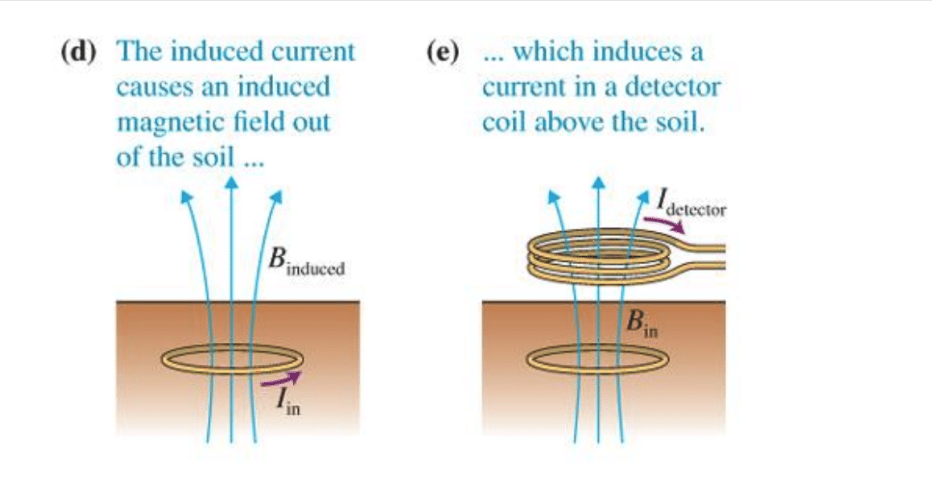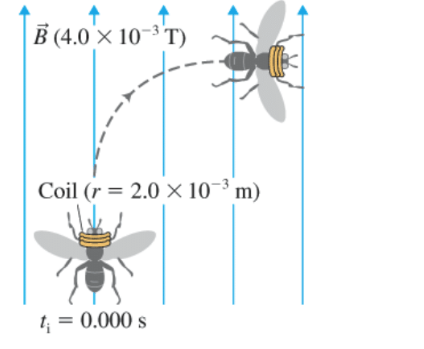
Concept explainers
BIO Magnetic induction tomography (MIT) Magnetic induction tomography is an imaging method used in mineral, natural gas, oil, and groundwater exploration, as an archaeological tool; and for medical imaging MIT has also been used to measure topsoil depth in agricultural soils. Topsoil depth is information that many farmers need for instance, corn yield is much higher in soil that has a deep topsoil layer above the underlying, impermeable claypan. Using a trailer attached to a tractor, a farmer can map an
(about 20-acre) field for topsoil depth in about 1 hour.
Figure 21.28 shows how MIT works A time-varying



BIO Measuring the motion of flying insects Studying the motion of flying animals, particularly small insects, is difficult. One method researchers use involves attaching a tiny coil with miniature electronics to the neck of an insect and another coil to its thorax (Figure 21.29 ). They place the insect in a strong magnetic field and observe the changing orientations and induced emfs of the two coils in the field as the insect flies. Suppose that a 50-turn coil of radius
-T magnetic field. The tsetse fly makes a


Which of the following could double the emf produced when the fly turns
a. Double the number of turns in the coil.
b. Double the coil’s area.
c. Double the magnitude of the external magnetic field.
d. Get the tsetse fly to take twice as long to turn.
e. a, b, and c
Want to see the full answer?
Check out a sample textbook solution
Chapter 21 Solutions
College Physics
Additional Science Textbook Solutions
Campbell Biology in Focus (2nd Edition)
Microbiology: An Introduction
Anatomy & Physiology (6th Edition)
Campbell Biology (11th Edition)
Physics for Scientists and Engineers: A Strategic Approach, Vol. 1 (Chs 1-21) (4th Edition)
Introductory Chemistry (6th Edition)
- Mick and Rick are twins born on Earth in the year 2175. Rick grows up to be an Earth-bound robotics technician while Mick becomes an intergalactic astronaut. Mick leaves the Earth on his first space mission in the year 2200 and travels, according to his clock, for 10 years at a speed of 0.75c. Unfortunately, at this point in his journey, the structure of his ship undergoes mechanical breakdown and the ship explodes. How old is Rick when his brother dies?arrow_forwardHi, I have canceled, why did you charge me again?arrow_forwardNo chatgpt pls will upvotearrow_forward
 College PhysicsPhysicsISBN:9781285737027Author:Raymond A. Serway, Chris VuillePublisher:Cengage Learning
College PhysicsPhysicsISBN:9781285737027Author:Raymond A. Serway, Chris VuillePublisher:Cengage Learning College PhysicsPhysicsISBN:9781305952300Author:Raymond A. Serway, Chris VuillePublisher:Cengage Learning
College PhysicsPhysicsISBN:9781305952300Author:Raymond A. Serway, Chris VuillePublisher:Cengage Learning Principles of Physics: A Calculus-Based TextPhysicsISBN:9781133104261Author:Raymond A. Serway, John W. JewettPublisher:Cengage Learning
Principles of Physics: A Calculus-Based TextPhysicsISBN:9781133104261Author:Raymond A. Serway, John W. JewettPublisher:Cengage Learning College PhysicsPhysicsISBN:9781938168000Author:Paul Peter Urone, Roger HinrichsPublisher:OpenStax College
College PhysicsPhysicsISBN:9781938168000Author:Paul Peter Urone, Roger HinrichsPublisher:OpenStax College
 Physics for Scientists and Engineers, Technology ...PhysicsISBN:9781305116399Author:Raymond A. Serway, John W. JewettPublisher:Cengage Learning
Physics for Scientists and Engineers, Technology ...PhysicsISBN:9781305116399Author:Raymond A. Serway, John W. JewettPublisher:Cengage Learning





